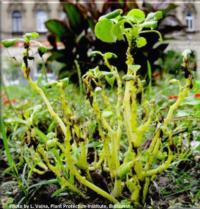Downy Mildew
-
Downy Mildew on Impatiens
Once again another common and easy to grow bedding plant, Impatiens walleriana, also known as simply impatiens, balsam, or Busy Lizzie, now has a new plant pathogen. Impatiens downy mildew, Plasmopara obducens, is a destructive foliar disease of Impatiens walleriana that is capable of causing complete defoliation or plant collapse, especially in landscape plantings under moist conditions and cool nights. While there have been sporadic reports of impatiens downy mildew in U.S. greenhouses since 2004, it was not until the summer of 2011 that regional outbreaks of this disease were seen for the first time in landscape beds and container plantings in North America.
In early January 2012, outbreaks of impatiens downy mildew were observed in landscape beds and greenhouses in south Florida. It is unclear whether this was a continuation of the 2011 outbreaks or a new cycle of disease for 2012. The spread of this disease continued throughout the spring, and by October 2012. Impatiens downy mildew (Plasmopara obducens) has been confirmed on Impatiens walleriana from landscapes in Oregon. There are unconfirmed reports of the pathogen in landscapes in the Portland Metro, Salem, and Corvallis areas. The Oregon Department of Agriculture is monitoring nurseries associated with the sales of infected impatiens.
Plasmopara obducens has been reported in several countries of Europe (Czech Republic, Denmark, Finland, Germany, Italy, Lithuania, the Netherlands, Romania, Russia, Slovenia, United Kingdom), as well as in Canada, USA, Guatemala, Central Asia, China, India and Korea (Farr & Rossman, 2011; Lane et al., 2005). New European outbreaks were reported first in Germany and United Kingdom (2003/2004). Disease incidence was high in many European countries listed above, approaching 100 percent, often resulting in plant losses of more than 90 percent. Outbreaks of the disease were often seen among plants that had been grown from imported cuttings.
The disease downy mildew on impatiens is caused by Plasmopara obducens. Like Pythium and Phytophthora, Plasmopara obducens is an Oomycete, or water mold. Oomycetes are more closely related to algae than to fungi. The spores have a tail which allows them to swim through water. Spread of infection can progress quickly in wet, moist conditions.
Controlling Downy Mildew of Impatiens
Avoidance and Removal: Avoid introducing impatiens downy mildew or any other disease into the landscape and commercial production. Check with the nursery about the health of landscape plants. Once infected plants have been identified, the first and best control is to remove the infected plants. Since one plant may be the source of inoculum for the rest of the bed or landscaping, removing that plant removes the initial inoculum. This is one of the principle rules of plants disease control. After removing the plant seal in a plastic bag and dispose of it away from any other impatiens. The oospores are short lived and dry out quickly. If the outbreak is in a commercial greenhouse, the plants should be disposed of and the bench area sterilized. Allowing infected plants to remain in the landscape may allow the pathogen to overwinter as resting structures (called oospores), which can start a new epidemic later in the year or in following years if impatiens are replanted in the area.
Fungicides: Fungicides work best when applied preventively. There are numerous fungicides for nursery and greenhouse production. Fungicide applications by home gardeners are not recommended since effective fungicides are not available to home gardeners. Cultural control and other methods listed above are effective.
Alternate plants: New Guinea Impatiens , Impatiens hawkeri, is resistant to downy mildew. This species of impatiens needs fertile, moist soil high in organic matter. They are more sun- loving than the other impatiens. They will tolerate more sun if their roots are kept moist. Incorporate a slow-release fertilizer into the soil before planting. They should only be planted after the danger of frost has passed and the ground has warmed.
There are also shade tolerant alternatives, such wax begonias, pansies, lobelia, torenia, caladium and coleus.
Reference:
Western Plant Diagnostic Network
First Detector News
Fall 2012 edition, volume 5, number 3

